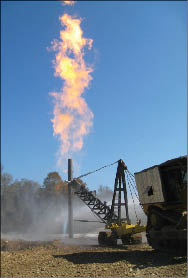When is the right time for training? The answer is always ‘now,’ and the well blowout stats prove it
By Brian Krause, Travelers Insurance
When 2,000 rigs were out in the field in 2008, drilling contractors barely had time to scratch, let alone think about sending their employees off for safety training. Now, with drilling activity decreasing to less than 1,000 rigs, many are more inclined to lay off workers than use the lull for learning new skills.
Big mistake.
Almost every well blowout that happens starts with human error, and most are preventable if the early warning signs are addressed right away. That means that the right time to train a drilling crew is now, regardless of whether the industry is in boom or bust mode.
 Almost every blowout starts with human error,
Almost every blowout starts with human error,
and most are preventable if the early warning signs
are addressed right away. Whether the industry is in a
bust or boom, training should always remain a priority.
Based on my 30 years of experience with capping runaway wells, my gut tells me that training pays off. For a more credible source, though, look at the statistics:
- In 2008, there were 28 out-of-control blowouts in the United States. The insurance company that covers a majority of the oil well industry – and makes free training available to every policyholder’s crew – was involved in only six of them.
- In 2006, the same insurer tracked blowouts and potential claims against the cost of providing 24/7 consultation and free training. The company estimated it saved $16.2 million.
Training obviously makes a difference.
WHY TRAINING GETS OVERLOOKED
There are always plenty of excuses for ducking training. First, the government does not require well certification for land-based employees as it does for offshore workers. Second, training costs both money and time, usually in short supply for most drilling contractors. Third, with the kind of turnover most operations see, why invest in training people who are here today and gone tomorrow?
Such excuses can all be answered: The government may be lagging behind in safety requirements, but that does not mean training should be skipped. Low- and no-cost training options are available, complete with sophisticated simulation and up-to-date technology. And training is an excellent motivator to keep good employees onboard even when competition for labor is tight.
The biggest barriers to training, however, are not the excuses but instead the culture of the business and the mentality of those involved. You have to be bold and aggressive to be successful in the oil industry, with a dash of luck thrown in. When something starts to go wrong with a well, some would just rather power through it and hope for the best. But hidden behind most success stories is a strong dose of the prudence and pragmatism that creates its own kind of “luck” by being prepared and taking the right steps at the right time.
Another long-embedded part of the culture and mentality is that if a well blows, insurance will pick up the tab for taking care of the mess and then the cost of redrill. This overlooks the fact that there are still plenty of costs associated with a well blowout that impact a contractor, including job delays, regulatory compliance responses, insurance deductibles and the potential for higher future premiums.
Finally, there is the culture and mentality that leaves a contractor certain that the operator who hires him does not want to hear that something is amiss, does not want to be told there may be a delay, and is completely uninterested in footing the bill for any remedial actions. What that means is that it is often too late to address a problem with simple solutions by the time the contractor calls for help. Training that teaches the contractor the early signs of a well going bad and instills the practice of calling on experts immediately can make a difference.
 Land contractors should use the down swing to build on
Land contractors should use the down swing to build on
employee training to help ensure safety in the future.
OVERCOMING BARRIERS
It is not easy to change a culture, create a new mentality and address every excuse that makes training seem impossible. Many large oil operations, however, are beginning to see the light and are investing in training on their own. Smaller operators can follow in their footsteps more easily if they look to their insurance company not just as a check writer when the worst scenario plays out, but as a partner in reducing risks.
Not all insurers provide the same level of risk management services, but it makes sense to ask if the following types of assistance are available:
- On-call expertise, with free 24/7 availability of oil industry veterans who can coach an operator through the steps to take once a well begins to kick.
- First-sign-of-trouble coverage, with the insurer picking up the bill for preventive action that is successful in avoiding a blowout and the necessity of a claim.
- Free and convenient training, with employees receiving IADC WellCAP certification upon completion.
- Emergency plan preparation, providing a customizable template for the actions that will be taken during a well crisis.
The oil industry has always been cyclical, and right now the market is bottoming out. The best contractors use these down swings to catch up on equipment maintenance, cull inept performers from their crews and keep their eyes open for the next opportunity.
If they are smart, contractors also increase skills and build employee loyalty by investing in training for their core crew members. Once the up-turn begins, the training is sure to pay off.




